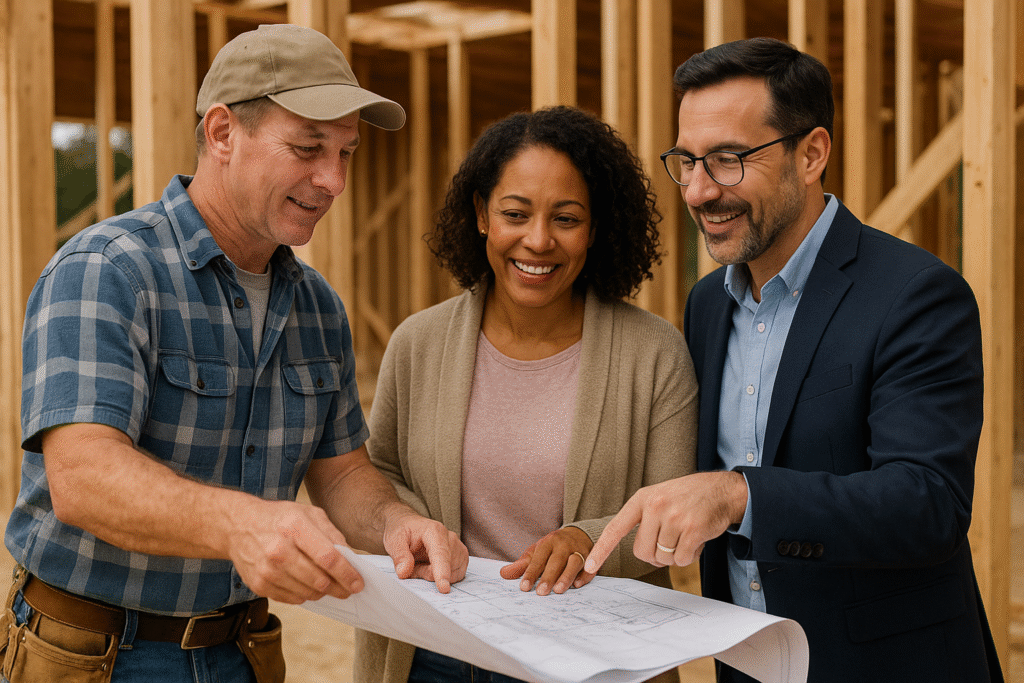
Construction Loan: Family Builds Custom Dream Home with Single-Close Convenience

Educational Case Study Disclosure
This case study is hypothetical and for educational purposes only. Scenarios, borrower profiles, loan terms, interest rates, and outcomes are illustrative examples and do not represent current offers or guaranteed terms.
For specific details including down payment requirements, closing cost estimates, interest rate details, closing cost breakdowns, payment calculations, cash-to-close estimates, or an official Loan Estimate, it is highly recommended you schedule a meeting with one of our licensed mortgage advisors.
Learn more:
- Construction loan Reg Z advertising requirements (§1026.24) – CFPB official regulation
- Construction loan Reg Z full text and compliance – Electronic Code of Federal Regulations
- Official construction loan advertising interpretations (§1026.24) – CFPB interpretations
- Construction loan MAP Rule (Reg N) mortgage advertising – Mortgage advertising rules
- NMLS Consumer Access – Verify construction loan lender licensure
Actual loan terms vary by credit profile, property, occupancy, location, market conditions, and lender guidelines. For current options tailored to you, schedule a consultation or apply online.
Ready to explore your options? Schedule a call with a loan advisor.
How This Construction-to-Permanent Loan Enabled Custom Home Building Without Double Closings
Robert and Jennifer M., a professional couple in their early 40s based in Fort Lauderdale, had been searching for their dream home for over two years without success. Robert, a software engineer, and Jennifer, a corporate finance manager, both worked primarily from home and needed dedicated office spaces—something most existing homes didn’t provide without major renovations. They also wanted entertaining spaces for hosting extended family, waterfront access for their love of boating, and an open floor plan reflecting modern lifestyle preferences.
After viewing dozens of existing homes that required extensive compromises or costly renovations, they decided building a custom home was the only way to get exactly what they needed. This wasn’t just about shelter—Robert and Jennifer viewed this as building generational wealth through a custom property that would serve their family for decades while appreciating in one of South Florida’s most desirable waterfront neighborhoods.
They found the perfect waterfront lot in a sought-after Fort Lauderdale neighborhood with deep-water canal access, mature landscaping, and southern exposure. With a trusted builder recommended by friends who’d built custom homes, detailed architectural plans tailored to their lifestyle, and a clear vision of their dream home, Robert and Jennifer were ready to begin construction. However, they needed construction financing that would make the building process as simple and cost-effective as possible while protecting them from rate volatility during the building period.
Facing similar challenges? Schedule a call to explore your options.
The Challenge: Why Traditional Two-Step Construction Financing Didn’t Work
Robert and Jennifer approached several construction lenders expecting the process would be similar to conventional mortgage applications they’d completed when purchasing their current home. Instead, they encountered complexity, substantial costs, and inflexible structures that didn’t align with their needs as first-time home builders looking to build long-term family wealth.
How Do Traditional Construction Loan Structures Work?
The first major challenge was the two-closing structure most construction lenders required. Traditional construction loans provide short-term financing during the building phase—typically at elevated interest rates reflecting construction risk. When construction completes, borrowers must obtain separate permanent mortgage financing, which requires a completely new application, qualification, appraisal, title work, and closing.
This means two distinct loan processes, two sets of fees and closing costs, and potential for qualification challenges if the borrower’s financial situation or credit changes during construction. For Robert and Jennifer, who were planning to build equity in this property over many years as the foundation of their family wealth, the uncertainty created unnecessary risk.
Why Did the Two-Closing Approach Create Financial Risk?
“The two-closing approach felt inefficient and risky,” Robert explained. “We’d pay closing costs twice. We’d go through underwriting twice. We’d need two appraisals and two title policies. We’d face uncertainty about whether we’d qualify for permanent financing after construction completed—what if interest rates rose significantly? What if one of us changed jobs during construction? What if our credit scores changed? The two-step process created too many variables and unknown costs that could threaten our long-term wealth-building plan.”
The second issue was interest rate risk. With traditional construction loans, borrowers lock a rate for the construction phase only. When construction completes and they apply for permanent financing, they get whatever the current market rate is at that time—which could be significantly higher than when they started. In rising rate environments, this creates substantial risk that monthly payments could increase dramatically between initial planning and permanent financing, potentially making the home unaffordable.
What Rate Uncertainty Did Robert and Jennifer Face?
“The rate risk worried us considerably,” Jennifer added. “We were planning based on current rates when we started the process. But construction takes months. If rates rose significantly during that time, our permanent mortgage rate could be much higher than we’d planned for, increasing our monthly payment substantially and affecting how much wealth we could build elsewhere. We wanted rate certainty from the beginning so we knew exactly what our housing costs would be for the long term.”
The third challenge was construction loan rates and fees. Traditional construction loans typically carry higher interest rates than permanent mortgages because they’re short-term with construction risk. Construction loan lenders also charge significant fees—origination fees, inspection fees at each draw stage, administration fees, and contingency reserves. When Robert calculated total costs including two closings, construction phase interest, and all fees, the financial burden was substantial.
How Does the Construction Loan Draw Process Work?
The fourth obstacle was draw process complexity. Construction loans release funds in stages—called “draws”—as construction progresses. Builders request draws at specific milestones, construction loan lenders send inspectors to verify work completion, and administrators review paperwork before releasing funds. This process involves coordination, delays, and potential for disputes if inspectors or lenders question work quality or completion percentages.
For first-time builders focused on creating a long-term family asset that would appreciate over decades, managing the draw process added stress and administrative burden they hadn’t anticipated. Additionally, Robert and Jennifer were concerned about construction delays impacting loan terms. Construction timelines often extend beyond initial projections due to weather, permit issues, subcontractor scheduling, material delivery delays, or unforeseen site conditions.
If construction extends significantly, traditional construction loans may require extensions, which trigger additional fees and potentially higher rates. The uncertainty about total project timeline and associated costs created planning challenges that threatened their wealth-building timeline.
“We needed construction financing that provided certainty, simplicity, and cost-effectiveness,” Robert said. “Two closings with double fees felt wasteful. Rate uncertainty created risk we couldn’t control. High construction loan rates and complex draw processes added costs and stress. For first-time builders trying to create our dream home and build family wealth, we wanted financing that simplified rather than complicated the process.”
Experiencing similar frustration with construction financing options? Schedule a call to discuss alternative solutions.
The Discovery: How Robert and Jennifer Found Construction-to-Permanent Loans
Robert and Jennifer’s builder, who had extensive experience with custom home construction, strongly recommended they explore construction-to-permanent loans—also called single-close construction loans—as an alternative to traditional two-step construction financing. The builder explained that many of his clients used construction-to-permanent loans because they offered significant advantages in cost, simplicity, and rate certainty for long-term homeownership.
What Makes Construction Loan Single-Close Programs Different?
Following the recommendation, Robert and Jennifer scheduled consultations with construction loan lenders specializing in construction-to-permanent financing. The lender explained how these loans work fundamentally differently than traditional two-step construction loans, addressing many of the concerns Robert and Jennifer had identified.
Construction-to-permanent loans provide single-close convenience—borrowers close once at the beginning, before construction starts. The rate locks at that initial closing, protecting against rate increases during construction. The loan provides construction financing during the building phase, then automatically converts to permanent mortgage financing when construction completes. No second closing. No second qualification. No second set of fees. One loan process from start to finish.
“That conversation immediately resolved our major concerns,” Jennifer explained. “Single closing meant we’d pay closing costs once, not twice. Rate locked at the beginning meant we had certainty about our future monthly payment regardless of what happened to rates during construction. Automatic conversion to permanent financing meant we didn’t have to requalify or worry about our financial situation changing. It was exactly the structure we needed to build our wealth without unnecessary financial risk.”
How Do Construction-to-Permanent Loan Rates Compare?
The construction loan lender also explained that construction-to-permanent loans typically offer competitive rates because lenders view them as permanent financing from the beginning, not short-term construction debt. The qualification focuses on the borrower’s ability to carry the permanent mortgage, similar to conventional mortgage underwriting. The draw process still involves inspections and milestone-based fund releases, but it’s integrated into a single loan structure rather than coordinating between construction lender and permanent mortgage lender.
Robert appreciated the timeline certainty construction-to-permanent loans provided. “With rate locked at the initial closing, we knew exactly what our monthly payment would be once construction completed. We could plan our budget confidently for the long term. We didn’t have to worry about rates rising during the extended construction period and finding out we suddenly couldn’t afford the permanent mortgage payment. The certainty was invaluable for financial planning and building stable family wealth.”
What Is the Construction Loan Process Timeline?
The construction loan lender walked through the process: initial application and qualification based on plans and lot, single closing before construction starts with rate locked, construction phase with periodic draws as work progresses, final inspection when construction completes, and automatic conversion to permanent mortgage without additional closing or fees. The borrower only pays interest on drawn funds during construction, then the loan converts to standard principal-and-interest payments when construction finishes.
“The structure made perfect sense for our situation,” Jennifer added. “We qualified once based on our income, credit, and financial position. We closed once, paying closing costs once. We locked our rate once, knowing exactly what we’d pay for decades to come. Construction happened over several months with draws released as work progressed. When construction finished, the loan automatically became our permanent mortgage. Simple, efficient, and cost-effective—exactly what we needed to build long-term wealth.”
The Solution: Construction-to-Permanent Loan Approval Process
Robert and Jennifer worked with their construction-to-permanent loan specialist to structure financing for their custom waterfront home. The process focused on their strong financial qualifications, the builder’s credentials and experience, and detailed construction plans with realistic timeline and budget.
What Construction Loan Documentation Was Required?
Documentation provided:
- Strong personal income from both Robert’s software engineering and Jennifer’s corporate finance positions
- Excellent credit scores with perfect payment history across all accounts
- Substantial liquid reserves demonstrating financial stability
- Appropriate down payment for construction-to-permanent financing
- Complete architectural plans with detailed specifications
- Comprehensive construction budget from licensed general contractor
- Builder’s credentials including license, insurance, bonding, and references
- Builder’s portfolio demonstrating experience with comparable waterfront custom homes
- Property appraisal for the completed home based on architectural plans
- Clear title on the waterfront lot they already owned
How Long Does Construction Loan Approval Take?
The approval process:
- Initial consultation – Discussed construction-to-permanent loan structure and advantages
- Document submission – Provided financial documentation, architectural plans, and builder credentials
- Builder vetting – Construction loan lender thoroughly evaluated contractor’s qualifications and track record
- Plan review – Underwriter analyzed construction plans and budget for feasibility
- Appraisal – Licensed appraiser valued the completed home based on plans and comparable properties
- Conditional approval – Approved subject to standard conditions
- Single closing – Closed on construction-to-permanent loan before breaking ground
- Rate locked – Secured favorable rate for entire construction period and permanent financing
- Construction phase – Draws released at milestone inspections over several months
- Final inspection – Home completed and passed final inspection
- Automatic conversion – Loan converted to permanent mortgage without second closing
The construction loan lender applied standard underwriting criteria evaluating Robert and Jennifer’s ability to carry the permanent mortgage comfortably. Their excellent credit, strong dual incomes, substantial reserves, and appropriate down payment all supported approval. The builder’s established reputation and experience with similar waterfront custom homes gave the lender confidence in successful project completion.
What Construction Loan Draw Schedule Did They Use?
During construction, the construction loan lender released funds according to a milestone-based draw schedule:
- Foundation draw – Released after foundation completion and inspection
- Framing draw – Released when framing completed with roof dried-in
- Rough-in draw – Released after mechanical, electrical, and plumbing rough-in completed
- Drywall draw – Released when drywall installed and finished
- Completion draw – Released at final inspection with certificate of occupancy
Each draw required inspection by the construction loan lender’s inspector to verify work completion before releasing funds to the builder. This protected Robert and Jennifer by ensuring payment aligned with actual construction progress, while providing the builder steady cash flow to keep the project moving forward.
Ready to purchase? Submit a purchase inquiry to discuss your scenario.
The Results: Robert and Jennifer Build Their Dream Home
Robert and Jennifer closed on their construction-to-permanent loan before breaking ground on their custom waterfront home. Construction progressed smoothly over several months, with draws released at each milestone as planned. The single-close structure eliminated the stress of requalifying for permanent financing mid-project, and the locked rate protected them from market volatility during the building period.
What Results Did Robert and Jennifer Achieve with This Construction Loan?
Final outcome:
- Closed once at the beginning with rate locked for entire process
- Avoided second closing and associated costs
- Protected from rate increases during construction period
- Construction completed successfully within reasonable timeline
- Loan automatically converted to permanent mortgage
- Timeline: Single closing to move-in ready in several months
- Property: Custom waterfront home with deep-water canal access, Fort Lauderdale, FL
- Features: Dedicated home offices, entertaining spaces, boat dock, open floor plan
- Long-term plan: Build family wealth through decades of homeownership and appreciation
How Does Construction-to-Permanent Financing Compare to Traditional Two-Step Loans?
Traditional two-step construction loan vs. construction-to-permanent loan:
- Traditional approach: Two closings with double costs and rate uncertainty
- Construction-to-permanent approach: Single closing with rate locked throughout
- Cost savings: Avoided substantial second closing costs
- Rate protection: Locked favorable rate before construction started
- Requalification risk: ELIMINATED ✓
- Process complexity: SIMPLIFIED ✓
- Long-term wealth building: ENABLED ✓
“Without the construction-to-permanent loan program, we would have faced significant additional costs, rate uncertainty, and requalification risk,” Robert explained. “The single-close structure saved us substantial money on duplicate fees and protected us from rate increases during construction. Most importantly, it gave us peace of mind knowing exactly what our housing costs would be for the long term.”
What Are Robert and Jennifer’s Long-Term Wealth Plans?
Robert and Jennifer view their custom home as their long-term primary residence where they’ll raise their family, enjoy waterfront lifestyle, and build memories over many years. The construction-to-permanent loan made the building process financially feasible and operationally smooth, turning their dream of custom homeownership into reality while building substantial equity in one of South Florida’s most desirable neighborhoods.
As their family grows and wealth accumulates, they’re already thinking about how the equity in this waterfront property could help them expand their real estate portfolio. In the future, they may consider using a HELOC or Home Equity Loan to access their home equity for investment purposes—allowing them to leverage their custom home’s appreciation without refinancing and losing the favorable rate they locked during construction.
“This home is the foundation of our family wealth,” Jennifer added. “We built exactly what we wanted, locked in excellent financing, and created an asset that will appreciate for decades. When we’re ready to expand our real estate investments, the equity we’re building here will help us acquire additional properties while preserving the great rate we secured through our construction-to-permanent loan.”
Ready to get started? Get approved or schedule a call to discuss your plans.
Exploring Other Construction Financing Options?
While Robert and Jennifer used construction-to-permanent financing for their custom primary residence, construction financing works for multiple scenarios:
- Building rental property? See how an investor used build-to-rent financing for rental construction
- Building for resale? See how a developer used build-to-sell financing for spec homes
- View all case studies to find success stories matching your situation
Key Takeaways for Custom Home Builders
What Can First-Time Builders Learn from This Construction Loan Success?
- Construction-to-permanent loans offer single-close convenience eliminating second closing and associated costs—substantial savings compared to traditional two-step construction financing (HUD construction guidelines)
- Rate locked at initial closing protects against increases during construction—critical protection in volatile rate environments providing payment certainty for long-term wealth planning
- Automatic conversion to permanent financing eliminates requalification risk—no concern about financial changes during construction affecting permanent financing or wealth-building timeline
- Builder credentials and experience critical for approval—construction loan lenders thoroughly vet contractors to ensure successful project completion
- Detailed construction plans and realistic budgets strengthen applications—comprehensive documentation demonstrates project feasibility and protects your investment
- Think beyond the single transaction—building a custom home creates long-term family wealth through appreciation, equity accumulation, and a unique asset tailored to your needs. Future equity can be leveraged through HELOCs for additional investments without losing your favorable locked rate
- Strong financial qualifications unlock favorable terms—excellent credit, substantial reserves, and solid income support approval and competitive construction loan rates
Have questions about construction-to-permanent loans? Schedule a call with a loan advisor experienced in custom home construction.
Alternative Loan Programs for Home Builders
If a construction-to-permanent loan isn’t the perfect fit, consider these alternatives:
- Renovation Loan – Purchase existing home with renovation financing included
- Lot Loan – Finance land purchase while planning construction
- Bridge Loan – Short-term financing for buying before selling current home
- Jumbo Loan – High-balance financing for luxury custom homes
- HELOC – Access equity for construction down payment or improvements
Explore all loan programs to find your best option.
Helpful Construction Loan Resources
Learn more about this loan program:
- Complete Construction Loan Guide – Detailed requirements and process
- Construction Loan Calculator – Estimate costs and scenarios
Similar success stories:
- How a family built their custom home with construction-to-permanent financing
- Investor builds rental property with build-to-rent construction loan
- View all case studies – Browse by construction type and goals
External authoritative resources:
- HUD construction guidelines – Federal housing construction standards
- Consumer Financial Protection Bureau mortgage resources – Borrower education and resources
Ready to get started?
- Apply online – Start your application
- Schedule a consultation – Discuss your custom home plans
- Take the discovery quiz – Clarify your building goals
Need local expertise? Get introduced to trusted partners including builders, architects, and real estate attorneys.
Need a Pre-Approval Letter—Fast?
Buying a home soon? Complete our short form and we’ll connect you with the best loan options for your target property and financial situation—fast.
- Only 2 minutes to complete
- Quick turnaround on pre-approval
- No credit score impact
Got a Few Questions First?
Not Sure About Your Next Step?
Skip the guesswork. Take our quick Discovery Quiz to uncover your top financial priorities, so we can guide you toward the wealth-building strategies that fit your life.
- Takes just 5 minutes
- Tailored results based on your answers
- No credit check required
Related Posts
Subscribe to our newsletter
Get the latest insights and mortgage case studies in your inbox.




